| Belize is leading the region in solid waste management. That's what we heard yesterday from an IDB Representative – and it denoted quite a change, since, not too long ago, here in the city we were choking on the putrid scent of our own garbage – burning out of control day and night.
Now, there's a transfer where that fetid dump once sat. Now, it will all be "transferred" to mile 24 on the Western Highway – which is quite a high tech location unto itself.
We were there for the opening yesterday and here's what we found:..
Daniel Ortiz reporting
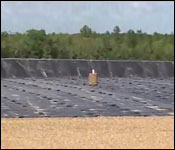 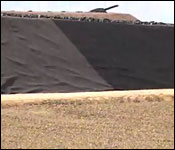  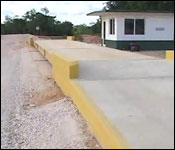 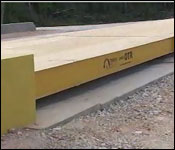 The newly opened Mile 24 Regional Landfill is like the Belize City Transfer Station, a vastly improved effort at dealing with waste. This facility has a total land space of 350 acres, and it is designed with the highest standards of garbage management. The clearing the facility measures about 5 acres of already cleared space, which will be used to dump the initial loads of garbage coming in. The other 345 acres will be cleared on a need-to basis to ensure that majority of the facility retains an untouched element of it to have very little impact on the environment which surrounds it. This Project, funded by the IDB and the Government of Belize, is designed with world-class standards in mind, and it will be able to accommodate waste coming from all parts of the country when fully activated. The newly opened Mile 24 Regional Landfill is like the Belize City Transfer Station, a vastly improved effort at dealing with waste. This facility has a total land space of 350 acres, and it is designed with the highest standards of garbage management. The clearing the facility measures about 5 acres of already cleared space, which will be used to dump the initial loads of garbage coming in. The other 345 acres will be cleared on a need-to basis to ensure that majority of the facility retains an untouched element of it to have very little impact on the environment which surrounds it. This Project, funded by the IDB and the Government of Belize, is designed with world-class standards in mind, and it will be able to accommodate waste coming from all parts of the country when fully activated.
Gilroy Lewis - Project Director, Solid Waste Management Authority
 "This sanitary landfill is a engineered facility. It means that the entire process from site selection, design and construction was done in a manner that it will protect human health and the environment, especially ground water and surface water. The overall principle of the sanitary landfill, is that of confinement and containment, and what do we hope to contain? We hope to contain the emissions that are derived from the decomposing solid waste. The emissions, for the most part, are both liquid and gaseous. So once we are able to contain these emissions, then we will be able to manage these emissions properly."
"This sanitary landfill is a engineered facility. It means that the entire process from site selection, design and construction was done in a manner that it will protect human health and the environment, especially ground water and surface water. The overall principle of the sanitary landfill, is that of confinement and containment, and what do we hope to contain? We hope to contain the emissions that are derived from the decomposing solid waste. The emissions, for the most part, are both liquid and gaseous. So once we are able to contain these emissions, then we will be able to manage these emissions properly."
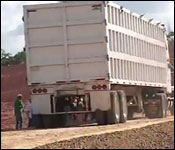 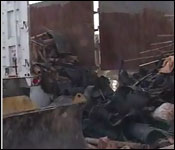 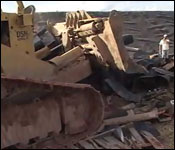 So, what actually happens when garbage arrives at the site? So, what actually happens when garbage arrives at the site?
Gilroy Lewis - Project Director, Solid Waste Management Authority
"The incoming waste that will be entering this facility from the transfer stations, will enter at the site entrance there. When you came in you saw a way bridge, which is a scale so the trailers will and the trucks will just pass over that way bridge and then they will park on the way bridge and then the weight of the truck will be taken and then that will be recorded in the computerized system so as to determine the weight of the garbage that is being brought into the facility. When that is accomplished, the trailer will continue along the internal access road and you are all familiar with the quality of the internal access road; it's well built and it will come around here and then it will access the cell right at that point and then it will go all the way to the end there, and then the load will be discharged."
And every load of garbage will be neatly placed in pre-planned locations.
Gilroy Lewis
"That will be accomplished in specific pre planned sub cells, so in other words, it's not a hazard, it's not a haphazard operation. Where every cubic meter of garbage is going, that's already planned; there are sub-cells where each amount of garbage is going to be disposed, and once there, it's going to be compacted to the smallest volume possible in order to preserve the air space and thereby extending the life of the landfill facility. The compaction of the garbage will be accomplished by means of a D-5 bulldozer and we visualize that when phase one and phase two are completed, the final elevation of the land form would be around thirty seven meters. Currently where we are, we are around elevation thirteen to fifteen meters above sea level and then the landfill will go up to thirty seven meters, so we are talking of a height of between one hundred to one hundred and ten feet more or less."
The management of both water and gaseous emissions is the key to the success of this dumping facility. It has mechanisms in place so that no untreated filthy water will be dumped into the environment from the decomposing garbage.
Gilroy Lewis
"Whenever solid waste is decomposing, it produces a contaminated liquid; that liquid there is going to be collected by the stones that you see right there behind us, that is the drainage layer and then the bottom of the landfill is sloped in such a way that the liquid will flow towards the East, where there is a series of collection pipes that are perforated and that will collect the contaminated liquid and then convey it all the way to the South Eastern portion of the cell and there are some submersible pumps there that will then pump out that water, and then send it to the lagoons."
The water will be treated, and the Department of Environment will be testing to ensure when it is safe to be discharged to the environment after a 40-day interval.
With all these elements in place at the facility, the IDB says that Belize is leaps and bounds ahead of its neighbors when dealing with waste.
Javier Grau Benaiges - Representative, IDB
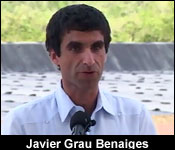 "Prior to this project there were no sustainable landfills in Belize, however, with today's inauguration - approximately 50% of Belize's population will benefit from proper disposal in a modern sanitary landfill. This puts Belize ahead of other countries in the region, such as Guatemala, Honduras, Nicaragua, Jamaica, Trinidad & Tobago and the Dominican Republic and the list could go on and on for Central America and the Caribbean. This, in terms of percentage of the total population that have access to solid waste treatment and proper disposal. No country, I can say this, no country in Central America or the Caribbean, has a sanitary landfill with a modern engineering designs and the modern technology for treatment that you can see here today at mile 24. Also consistent with the national sustainable tourism master plan for Belize for 2013 - Belize is now solving one of its main constraints for tourism growth. Until now the solid waste management has had a negative impact on Belize's image and the tourist perception of the country, however, with this opening, this perception is going to change."
"Prior to this project there were no sustainable landfills in Belize, however, with today's inauguration - approximately 50% of Belize's population will benefit from proper disposal in a modern sanitary landfill. This puts Belize ahead of other countries in the region, such as Guatemala, Honduras, Nicaragua, Jamaica, Trinidad & Tobago and the Dominican Republic and the list could go on and on for Central America and the Caribbean. This, in terms of percentage of the total population that have access to solid waste treatment and proper disposal. No country, I can say this, no country in Central America or the Caribbean, has a sanitary landfill with a modern engineering designs and the modern technology for treatment that you can see here today at mile 24. Also consistent with the national sustainable tourism master plan for Belize for 2013 - Belize is now solving one of its main constraints for tourism growth. Until now the solid waste management has had a negative impact on Belize's image and the tourist perception of the country, however, with this opening, this perception is going to change."
The value of the mile 24 Regional landfill is estimated at 4 million US Dollars. The Authorities say that 2 million dollars was saved in the budget for the construction of this facility.
|

